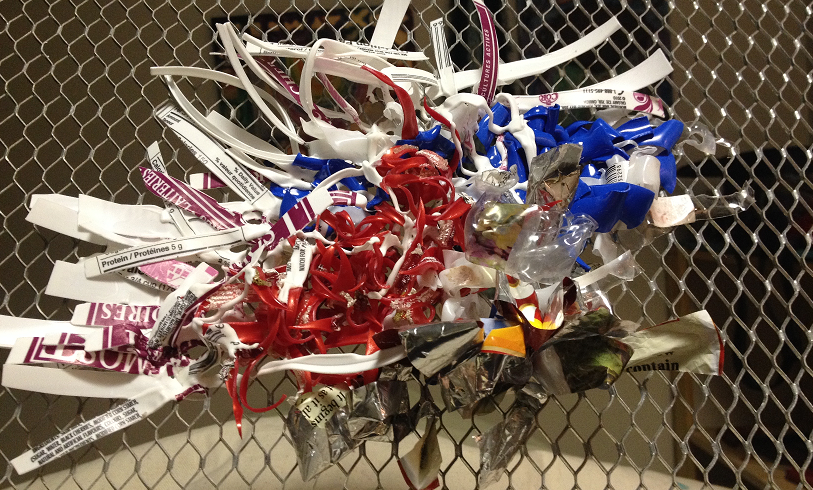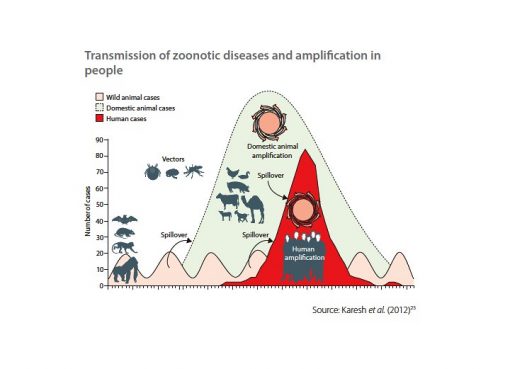Himasri Das
PhD student (Veterinary Microbiology)
College of veterinary science, Assam Agricultural University
Khanapara, Guwahati-22
Synthetic plastics are being used to serve different purposes due to their high flexibility in nature, easy and low cost of production, where 64% of synthetic based plastics is covered by polythene. The bottom up application of plastic in various fields like manufacture of bottles, carry bags, margarine tubs, milk jugs, disposable articles, garbage containers and water pipes drew attention during 19th and 20th centuries. However, the emerging indiscriminate use of plastic in different sectors such as agriculture, consumer goods, health and medicine is now tagged along with plastic waste which has started soiling the environment.
Plastic waste is considered as the second largest solid waste where the accumulation rate is found to be approximately 25 million tons/year making it a global concern. Different categories of plastics are replacing paper or cellulose based products due to the attached traits like high tensile strength that ultimately proposes an annual demand of 140 million tons. The plastics of various forms such as nylon, polycarbonate, polyethylene-terephthalate, polyethylene, polypropylene, polystyrene, polytetra-fluouroethylene, polyurethane and polyvinyl chloride are being continuously used in day-to-day activity. These synthetic products are made from petrochemicals by different processes like addition, polymerization (polyolefin) or by condensation reactions (polyester, polyamide). This high consumption of plastic is terminated creating a plastic menace with potential threat to the environment due to its least rate of degradation or non-biodegradability of the organic materials under natural condition. Hence, the persistency of plastic in the environment has attracted researchers from a different point of view.
Plastic waste management remains as an ongoing and continuing challenge for in the research field as the prolonged deposit of plastic is not only confined to an environmental hazard but also a health hazard. Recent researchers are focussing on using microbial enzymes for removal of plastic from environment. Many microorganisms are known to degrade plastic which include fungi, algae as well as bacteria. Generally fungi are known to have a higher degradation efficiency compared to bacteria. Plastic is identified as a recalcitrant polymer that is corrosion resistant. Involvement of a number of bacterial spp. such Bacillus, Pseudomonas, Klebsiella, Mycobacterium, Rhodococcus, Flavobacterium, Escherichia, Nocardia, and Azotobacter is reported to cause degradation of plastic by producing different degrading enzymes. These enzymes cleave the polymers and convert them into the monomers for easy absorption by the microbial cells. Incubation with microorganisms can bring changes in the concentrations of functional groups on the surface of a polyethylene substrate. This occurs either because of their consumption or production. The more hydrophilic the surfaces are the more easy colonization can be observed. However, increase in the hydrophilicity is seen when the extent of the oxidation process due to the action of abiotic factors such as UV light or activity of enzymes is higher than the extent of consumption of functional groups. Both CO2 as well as water are aerobic metabolic products after degradation, and CO2, water and methane are anaerobic metabolic product. Apart from these few surface acting agents like bio-emulsifiers are produced to enhance the degradation process. Hydrophobicity, high molecular weight and lack of functional groups with the presence of stable covalent bonds (C-H or C-C) are the attributing factors for difficulty in degradation of the plastic materials, as the functional groups provide the targets for those cleaving enzymes secreted by the micro organisms. Therefore, pre-treatment is beneficial that helps in either adding functional group or to cause depolymerisation of chains. UV treatment causes addition of the carbonyl group as well as reduction of the molecular weight of the plastic polymer. Polyethylene degradation can be classified as abiotic, caused by environmental factors such as temperature and UV irradiation, while in case of biotic classification, the deterioration is caused by the action of microorganisms that modify and consume the polymer leading to changes in its properties. However, in few studies combination of both factors using a thermo-chemical or a photochemical step (UV radiation or γ-radiation) followed by bio-processing is proved to be an excellent approach.
Reportedly S. marcescens can take part in abiotic degradation where the pigments present in them act as photo-concentrator that guide the elements of the sun’s rays falling onto a particular point on the polymer chain that ultimately leads to chain scission. Even a hypothesis also has been made that the pigment promotes some photons to higher energy levels that acts the source for causing scission and subsequent degradation of the plastic product. The reduced chains then can be ingested by the microbes as fatty acyl chains. The bacteria can utilize these degraded products as carbon source for their further growth. For example- Rhodococcus rubber can use the digested product as carbon source and after metabolism produces polysaccharide and proteins.
PET is the Polyethylene terephthalate primarily used for production of bottles, foils and fibres in textile industry. Different enzymes are known to cause degradation of such products are PET hydrolase and tannase, MHETase, which are typical serine hylase along with presence of few disulphide bonds that exist to promote thermal stability as well as for specific binding to PET. Such enzymes are known to be secreted by Ideonella sakaiensis. This bacterium usually secretes two types of enzymes after attaching onto the surface of the PET. One makes an intermediate product when mixed with plastic and then taken it up by the microbial cell. After that another enzyme digests this intermediate product and uses them as carbon source and this process takes around 6 weeks at 30°C. Another gram-positive phylum Actinobacteria is also known to have the potential for PET digestion. However, the best characterized examples are genera Thermobifida and Thermomonospora. Few strains of soil-dwelling bacteria like Pseudomonas, Flavobacterium, Arthrobacter and Agromyces are investigated to carry out hydrolysis or oxidative attack on polyamide nylon.
Plastic is identified as chemical burden for the marine environment too where it litters many huge water bodies like oceans. The reason behind it is that not only single toxic material known as phthalate but also many other toxic chemicals such as persistent organic pollutants present in plastic can be absorbed in the ocean. Polyethylene biodegradation is measured as the extent of weight reduction by the microorganisms at a particular temperature and it is universally acceptable. It has been reported that Pseudomonas strain has the ability to reduce the polythene by 20% within 120 day. Volatile compounds are reported to be produced during the metabolism by Pseudomonas. Pseudomonas alcaligenes can degrade 10.5, 14.7 and 16.2 % of polythene respectively in 10, 20 and 30 days of incubation. In another study two gut-residing bacteria found in Indian meal moths or wax worms, namely Enterobacter asburiae and Bacillus spp. are known to reduce the weight even faster. Brevibacillus borstelensis degrades the CH2 backbone in the plastic to use as the sole carbon source.
Few gram-positive bacteria like – Microbacterium awajiense, Rhodococcus jostii, Mycobacterium vanbaalenii and Streptomyces fulvissimus isolated from earth worm (Lumbricus terrestris) are able to decay the plastic product as early as 21 days. In a study it is said that biodegradation of plastic is a result of a cooperative process between among different species of microbes that mainly depend on differ in their density as well as degree of branching on the polymers. Bacteria of the genus Bacillus is said to have the highest capacity of degradation but further assessment is to be done though. Now a days, polythenes are often treated or mixed with additives such as pro-oxidants or starch to improve the bio-degradability of the polymers by helping through enhancement of bacterial colonization on the polymeric surface. Although enough evidences are highlighted to prove about the bio-degradation process but further knowledge regarding the metabolic pathways is still needed to adapt. However, identification of these enzymes and analysis of their structures require further study and along with that further assessment of the conditions for microbial activity is also required.
References
Bassi, A., 2017. Biotechnology for the management of plastic wastes. In Current developments in biotechnology and bioengineering (pp. 293-310). Elsevier.
Begum, M.A., Varalakshmi, B. and Umamagheswari, K., 2015. Biodegradation of polythene bag using bacteria isolated from soil. Int J Curr Microbiol App Sci, 4(11), pp.674-680.
Danso, D., Chow, J. and Streit, W.R., 2019. Plastics: environmental and biotechnological perspectives on microbial degradation. Applied and environmental microbiology, 85(19).
Hadad, D., Geresh, S. and Sivan, A., 2005. Biodegradation of polyethylene by the thermophilic bacterium Brevibacillus borstelensis. Journal of applied microbiology, 98(5), pp.1093-1100.
Kyaw, B.M., Champakalakshmi, R., Sakharkar, M.K., Lim, C.S. and Sakharkar, K.R., 2012. Biodegradation of low density polythene (LDPE) by Pseudomonas species. Indian journal of microbiology, 52(3), pp.411-419.
Lwanga, E.H., Thapa, B., Yang, X., Gertsen, H., Salánki, T., Geissen, V. and Garbeva, P., 2018. Decay of low-density polyethylene by bacteria extracted from earthworm’s guts: A potential for soil restoration. Science of the Total Environment, 624, pp.753-757.
Odusanya, S.A., Nkwogu, J.V., Alu, N., Udo, G.E., Ajao, J.A., Osinkolu, G.A. and Uzomah, A.C., 2013. Preliminary studies on microbial degradation of plastics used in packaging potable water in Nigeria. Nigerian Food Journal, 31(2), pp.63-72.
Restrepo-Flórez, J.M., Bassi, A. and Thompson, M.R., 2014. Microbial degradation and deterioration of polyethylene–A review. International Biodeterioration & Biodegradation, 88, pp.83-90.
Sangale, M.K., Shahnawaz, M. and Ade, A.B., 2012. A review on biodegradation of polythene: the microbial approach. J Bioremed Biodeg, 3(10), pp.1-9.
Shimao, M., 2001. Biodegradation of plastics. Current opinion in biotechnology, 12(3), pp.242-247.
Soud, S.A., 2019. Biodegradation of Polyethylene LDPE plastic waste using Locally Isolated Streptomyces sp. Journal of Pharmaceutical Sciences and Research, 11(4), pp.1333-1339.
Yang, J., Yang, Y., Wu, W.M., Zhao, J. and Jiang, L., 2014. Evidence of polyethylene biodegradation by bacterial strains from the guts of plastic-eating waxworms. Environmental science & technology, 48(23), pp.13776-13784.




